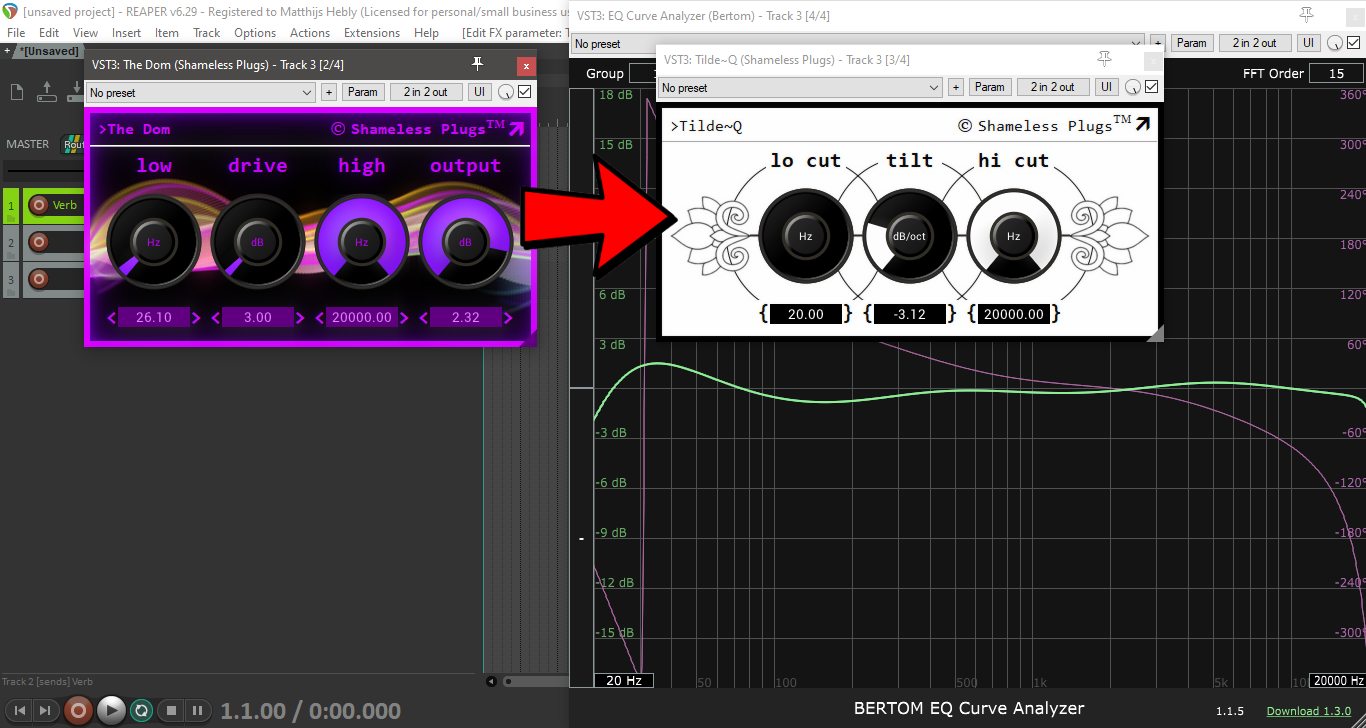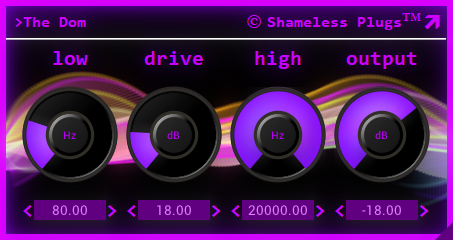Shameless Plugs™
Introduction
The Dom is in the house, and it is unmistakable.
The Dom is a frankly brutal distortion, overdrive and amplifier plugin. It is not here to sit quietly in the corner and gently handle all your audio bits with the greatest care; it is here to rock & roll.
Although The Dom is most definitely not modelled after any existing hardware distortion or overdrive pedal or amp in particular (because that's simply not how we (rock &) roll here at Shameless Plugs headquarters), we most definitely expect it to be the first distortion, overdrive and amplifier plugin that future hardware units will be modelled after.
Use cases
Because of its simplicity, and because of Shameless Plugs' philosophy to keep the Paradox of Choice at bay by offering exactly the right number of controls, dialling in the right sound is almost child's play.
The Dom will successfully fulfil the role of an overdrive, pushing whatever comes after it into saturation; or a distortion in its own right in front of e.g. a cleaner amp; or even as a complete replacement for an amplifier.
The high cut filter can be sufficient to shape the sound by cutting out unwanted fizziness that necessarily comes from any type of distortion, before sending it to e.g. a reverb, or you can use a speaker cabinet simulator or impulse response loader with your favourite speaker cabinet impulse response, to shape the sound. The choice is yours.
No one or no thing but your impeccable taste should dictate what kinds of
sounds you can apply The Dom to, but typical sources include of course the
electric guitar (which will find its natural habitat in The Dom), the
Hammond organ, the bass guitar (typically applied in parallel, mixing in
with the bass guitar's natural timbre), lead synthesizer parts, etc.
And vocals can be processed in full, in order to create a telephone
effect, or bullhorn effect.
Music composed and performed by Matthijs Hebly.
But The Dom can also act more subtly, as an exciter, by applying a radical low cut (up into the kHz range), adjusting the drive to create some mild saturation upto fairly heavy distortion, and mixing some of this in with the dry signal. This works well on e.g. vocals, brass, strings, and anything else that needs a little extra shine and presence in order to stand out better in the mix.
Yet another use case is applying The Dom in combination with
our Tilde~Q:
The Dom itself broadly has an inherent EQ curve with a +3.0dB/octave
upward slope, so combining it with a
Tilde~Q
set to slope downwards by -3.0dB/octave will result in a frequency curve
that is almost (but not entirely) flat. If we put the
Tilde~Q after The Dom,
its saturation will be made more mellow, whereas putting
Tilde~Q before it will accentuate
The Dom's more crunchier side.
We can now apply this combination of The Dom ⇒
Tilde~Q as a kind of tape saturation;
this sounds just as good on individual sources as it does on entire mixes.
Depending on the setting of the low cut control of The Dom,
there will even be a slight low frequency bump, as is typical in tape
devices.
To compensate the gain, set the output control such that the drive and
output values add up to at least +3.0dB; higher drive values with more
saturation will typically require a more radical compensation.

Comparison to similar plugins
On the surface, The Dom might seem similar to many other distortion– / saturation–type plugins.
However, quite a lot goes on under the hood, to make it as versatile as possible, while maintaining a remarkable ease of use, by offering only the controls needed, no more, no less.
The drive section employs a sophisticated, gentle, asymmetrical waveshaper that generates and emphasises pleasant even–order harmonics, very similar to what happens in the best Class A tube amplifiers.
Carefully crafted, intricate filter sections, both before and after the drive section, maximize the plugin's versatility.
I use The Dom as an amp, going straight into a Mikko speaker cabinet simulator.
A LoudMax instance is used as a simple compressor pedal, before The Dom.
Music composed and performed by Matthijs Hebly.
What's included
Both this free version, as well as the future paid version, offer:
-
The main drive control, allowing for a gain ranging from
0.0dB all the way up to a whopping +96.0dB to be pushed into the
waveshaper.
-
A 24dB/octave low cut control, which is internally split up
into two 12dB/octave filters, one positioned before the drive section,
and the other positioned after it.
This cancels any DC entering the circuit (vital for accurate waveshaping), as well as any DC generated by the waveshaper itself, and prevents it from propagating any further into the circuit.
Setting this control appropriately for the source will help tighten the bass response.
-
A 24dB/octave high cut control, to be applied to taste, e.g.
to cut out any fizziness, etc.
- An output control, with sufficient extra gain available when using The Dom as a powerful overdrive, to push any amplifier simulator after it into saturation, distortion, and beyond.
User interface
The friendly user interface offers very detailed, fine-grained control.
While using the mouse, the Ctrl and Shift keys allow for very small
adjustments.
Alternatively, precise values can be entered in the edit boxes.
The user interface as a whole is resizable, using the size grip in the
bottom-right corner.
Future paid version
Apart from the four main controls that the free version offers, the paid
version will offer additional controls for phase, mix, and bypass, and
will offer control over the internal EQ slope, as well as a mid scoop, to
enable the creation of tones revered in the heavy metal genre.
It might include a speaker cabinet simulator as well.
The paid version will also feature optional oversampling in order to prevent aliasing.
Recommended
Other recommended plugins:
Download
The Dom is currently available for Windows, 64 bit.
Please make sure to read and agree to the EULA before downloading.
Version history
-
1.0.1
-
Bug fix to allow Shameless Plugs' plugins to run on Steinberg DAWs
Cubase and Nuendo.
There are now no DAWs known to not run Shameless Plugs' plugins.
-
Bug fix to allow Shameless Plugs' plugins to run on Steinberg DAWs
Cubase and Nuendo.
-
1.0.0
- Initial release.
